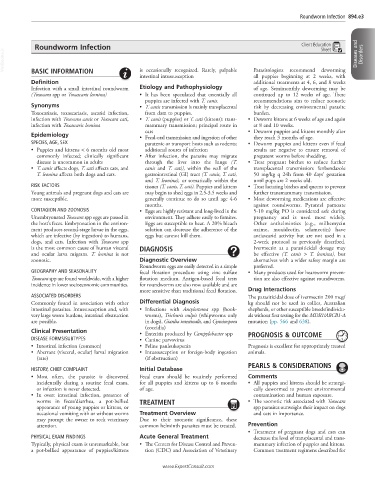Page 1786 - Cote clinical veterinary advisor dogs and cats 4th
P. 1786
Roundworm Infection 894.e3
Roundworm Infection Client Education
Sheet
VetBooks.ir Diseases and Disorders
is occasionally recognized. Rarely, palpable
BASIC INFORMATION
intestinal intussusception Parasitologists recommend deworming
all puppies beginning at 2 weeks, with
Definition additional treatments at 4, 6, and 8 weeks
Infection with a small intestinal roundworm Etiology and Pathophysiology of age. Semimonthly deworming may be
(Toxocara spp or Toxascaris leonina) • It has been speculated that essentially all continued up to 12 weeks of age. These
puppies are infected with T. canis. recommendations aim to reduce zoonotic
Synonyms • T. canis transmission is mainly transplacental risk by decreasing environmental parasite
Toxocariasis, toxascariasis, ascarid infection, from dam to puppies. burden.
infection with Toxocara canis or Toxocara cati, • T. canis (puppies) or T. cati (kittens): trans- • Deworm kittens at 6 weeks of age and again
infection with Toxascaris leonina mammary transmission; principal route in at 8 and 10 weeks.
cats • Deworm puppies and kittens monthly after
Epidemiology • Fecal-oral transmission and ingestion of other they reach 3 months of age.
SPECIES, AGE, SEX paratenic or transport hosts such as rodents: • Deworm puppies and kittens even if fecal
• Puppies and kittens < 6 months old most additional routes of infection results are negative to ensure removal of
commonly infected; clinically significant • After infection, the parasite may migrate prepatent worms before shedding.
disease is uncommon in adults through the liver into the lungs (T. • Treat pregnant bitches to reduce further
• T. canis affects dogs, T. cati affects cats, and canis and T. cati), within the wall of the transplacental transmission: fenbendazole
T. leonina affects both dogs and cats. gastrointestinal (GI) tract (T. canis, T. cati, 50 mg/kg q 24h from 40 days’ gestation
and T. leonina), or somatically within the until pups are 2 weeks old.
RISK FACTORS tissues (T. canis, T. cati). Puppies and kittens • Treat lactating bitches and queens to prevent
Young animals and pregnant dogs and cats are may begin to shed eggs in 2.5-3.5 weeks and further transmammary transmission.
more susceptible. generally continue to do so until age 4-6 • Most deworming medications are effective
months. against roundworms. Pyrantel pamoate
CONTAGION AND ZOONOSIS • Eggs are highly resistant and long-lived in the 5-10 mg/kg PO is considered safe during
Unembryonated Toxocara spp eggs are passed in environment. They adhere easily to fomites. pregnancy and is used most widely.
the host’s feces. Embryonation in the environ- Eggs are susceptible to heat. A 20% bleach Other anthelmintics (e.g., milbemycin
ment produces second-stage larvae in the eggs, solution can decrease the adherence of the oxime, moxidectin, selamectin) have
which are infective (by ingestion) to humans, eggs but cannot kill them. antiascarid activity but are not used in a
dogs, and cats. Infection with Toxocara spp 2-week protocol as previously described.
is the most common cause of human visceral DIAGNOSIS Ivermectin at a parasiticidal dosage may
and ocular larva migrans. T. leonina is not be effective (T. canis > T. leonina), but
zoonotic. Diagnostic Overview alternatives with a wider safety margin are
Roundworm eggs are easily detected in a simple preferred.
GEOGRAPHY AND SEASONALITY fecal flotation procedure using zinc sulfate • Many products used for heartworm preven-
Toxocara spp are found worldwide, with a higher flotation medium. Antigen-based fecal tests tion are also effective against roundworms.
incidence in lower socioeconomic communities. for roundworms are also now available and are
more sensitive than traditional fecal flotation. Drug Interactions
ASSOCIATED DISORDERS The parasiticidal dose of ivermectin 200 mcg/
Commonly found in association with other Differential Diagnosis kg should not be used in collies, Australian
intestinal parasites. Intussusception and, with • Infections with Ancylostoma spp (hook- shepherds, or other susceptible breeds/individu-
very large worm burdens, intestinal obstruction worms), Trichuris vulpis (whipworms only als without first testing for the MDR1/ABCB1-Δ
are possible. in dogs), Giardia intestinalis, and Cystoisospora mutation (pp. 566 and 638).
(coccidia)
Clinical Presentation • Enteritis produced by Campylobacter spp
DISEASE FORMS/SUBTYPES • Canine parvovirus PROGNOSIS & OUTCOME
• Intestinal infection (common) • Feline panleukopenia Prognosis is excellent for appropriately treated
• Aberrant (visceral, ocular) larval migration • Intussusception or foreign-body ingestion animals.
(rare) (if obstruction)
PEARLS & CONSIDERATIONS
HISTORY, CHIEF COMPLAINT Initial Database
• Most often, the parasite is discovered Fecal exam should be routinely performed Comments
incidentally during a routine fecal exam, for all puppies and kittens up to 6 months • All puppies and kittens should be strategi-
or infection is never detected. of age. cally dewormed to prevent environmental
• In overt intestinal infection, presence of contamination and human exposure.
worms in feces/diarrhea, a pot-bellied TREATMENT • The zoonotic risk associated with Toxocara
appearance of young puppies or kittens, or spp parasites outweighs their impact on dogs
occasional vomiting with or without worms Treatment Overview and cats in importance.
may prompt the owner to seek veterinary Due to their zoonotic significance, these
attention. common helminth parasites must be treated. Prevention
• Treatment of pregnant dogs and cats can
PHYSICAL EXAM FINDINGS Acute General Treatment decrease the level of transplacental and trans-
Typically, physical exam is unremarkable, but • The Centers for Disease Control and Preven- mammary infection of puppies and kittens.
a pot-bellied appearance of puppies/kittens tion (CDC) and Association of Veterinary Common treatment regimens described for
www.ExpertConsult.com

